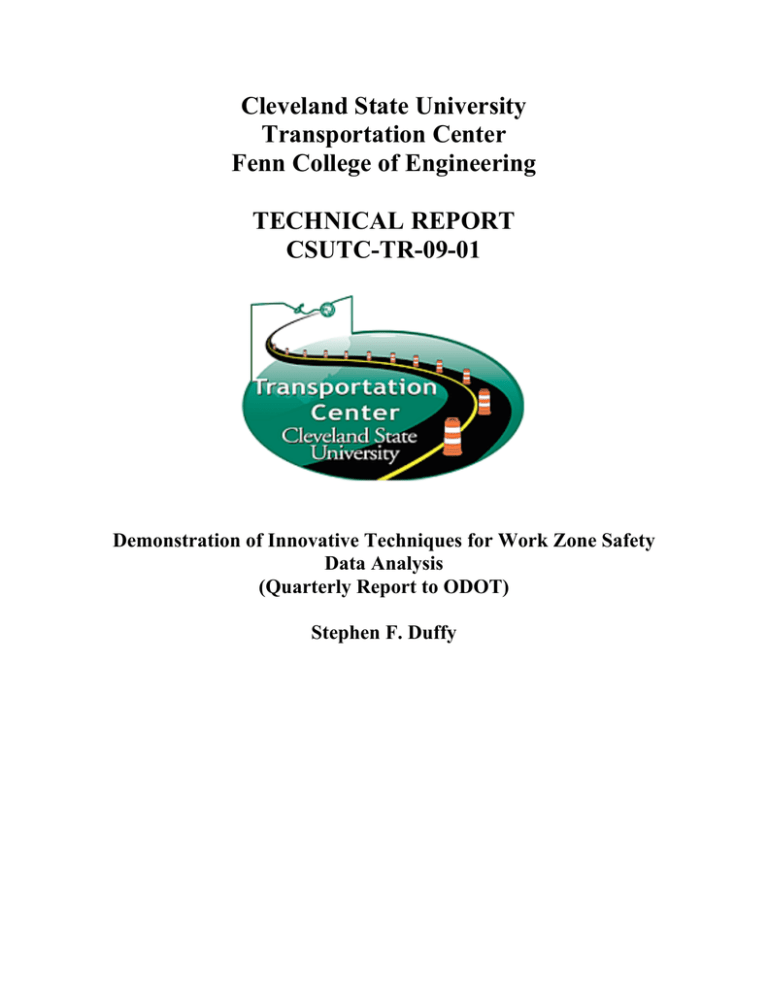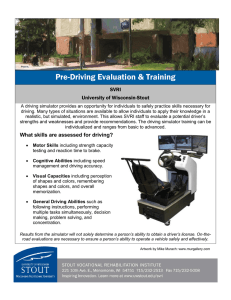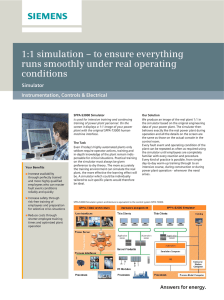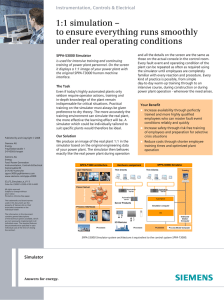Cleveland State University Transportation Center Fenn College of Engineering
advertisement

Cleveland State University Transportation Center Fenn College of Engineering TECHNICAL REPORT CSUTC-TR-09-01 Demonstration of Innovative Techniques for Work Zone Safety Data Analysis (Quarterly Report to ODOT) Stephen F. Duffy OHIO DEPARTMENT OF TRANSPORTATION QUARTERLY RESEARCH REPORT For Quarter Ending March 31, 2009 Date Submitted June 5, 2009 Project Title: Demonstration of Innovative Techniques for Work Zone Safety Data Analysis Research Agency: Cleveland State University Principal Investigator(s): Stephen F. Duffy State Job No.: 134332 Agreement No.: 21457 Pooled Fund Study No. (if applicable): ________ Project Start Date: May 1, 2007 Contract Funds Approved: $61,316 ($121,660 - CSU match) Project Completion Date: July 1, 2009 (revised) Spent To Date: $57,141.86 ($207,006.50 - CSU match) % Funds Expended 93% ( 170% - CSU match) Work Done _ 85% Time Expired 65% List the Technical Liaisons and other individuals who should receive copies of this report: Monique Evans, Jennifer Gallagher, Omar Abu-Hajar, Karen Pannell, Jill Martindale, Vicky Fout SUMMARY OF PROGRESS FOR QUARTER: Schedule of Research Activities As of March 31, 2009, approximately 93% of the research has been completed. Figure 1 shows the proposed time schedule for each research task and the actual schedule of Trans #: Page 3 of 9 work completed on each task to date. Figure 1. Schedule of research activities During the seventh quarter, the simulator scenarios developed were implemented and test subjects participated in the simulations. The pilot study was completed. The only tasks that remain are the pilot study data analysis and preparing the final report Actual vs. Estimated Expenditures Figure 2 shows actual vs. estimated expenditures for work completed during the seventh quarter. As of March 30, 2009 approximately 93% of the proposed work was estimated to be completed according to the schedule shown in Figure 1 and the work time schedule provided in the original proposal. Figure 2. Estimated vs. Actual Expenditures (ODOT Funds) Estimated expenditures of ODOT as of March 30,2009 were $57,119.47 (calculated as 93% of total budget). The actual expenditures were $57,141.86. Figure 3. Estimated vs. Actual Expenditures (CSU Matching Funds) Estimated expenditures of CSUʼs matching funds as of March 30,2009 were $113,333.46 (calculated as 93% of total budget). The actual expenditures were $207,006.50. Trans #: Page 5 of 9 Percent Completion of Research At the end of the fifth quarter of this grant approximately 93% of the research as been completed. Literature Review The literature review has been completed and reported on in an earlier report. 100 Car Study Data Analysis CSU received the VTTI deliverables. The data includes an excel spreadsheet representing all the relevant variables associated with all 100-Car Study crashes, nearcrashes, and incidents that occurred in a work zone. In addition, CSUʼs analysis of Ohio work zone crash data is complete. Simulator Development Scenario development began in January 2008 with the creation of virtual work zones in driving simulator scenarios. The work zones include traffic control devices and signs placed on the roadway in accordance with the Ohio MUTCD. These work zones will be used in the validation and pilot studies. Details of each of the scenarios were provided in the previous quarterly report. Work on developing the simulation scenarios is complete. Validation Study The validation study would have been developed and conducted based on the findings obtained from the naturalistic data analysis in comparison to data obtained from the driving simulator. A quanitative validation analysis will not be conducted. Information regarding the work zone configuration for the Virginia Tech data was never archived making the validation study impossible to conduct. Pilot Study A revised pilot study was developed based on collaboration with ODOT. The pilot study was reported on in the last quarterly report. ODOT will conduct a site visit to discuss elements of the pilot study implemented into the reported scenarios. A total of 4 scenarios will be presented to study participants. Each scenario will contain 6 treatment combinations (3 on divided roads, 3 on undivided roads). The order in which treatment combinations appear in the scenario was counterbalanced to prevent confounding. The order in which scenarios are presented to each participant was also randomized. Treatment combinations were reported on in the last quarterly report. Data has been collected and the pilot study is complete. The data from the pilot study is being analyzed and the final report for this project is under preparation. IMPLEMENTATION (if any): N/A PROBLEMS & RECOMMENDED SOLUTIONS (if applicable): A contract extension of one year was requested and granted by Monique Evans on June 9, 2008. The extension was requested due to the delays associated with the IRB approval and the by the fact that the original PI, Professor Nancy Grugle has left CSU. As noted in the previous report, with the completion of the semester at CSU, obtaining subjects for the pilot study will be difficult. Therefore, the majority of the pilot study will have to be completed when school commences in the fall. As to the departure of Professor Nancy Grugle, Professor Stephen Duffy has proposed to ODOT that he take over the grant as PI in order to finish the research. Professor Duffy reached out to Professor Deb McAvoy at Ohio University to help in completing the data analysis. A contract for Professor McAvoyʼs services was prepared and forwarded to Ohio University. This project will be finished as a joint collaboration with Ohio University. The pilot study consisted of a number of simulations. In conducting these experiments initially, the majority of the test subjects experiencing simulator sickness. In this report we present a model of how the data collected correlates with the incidence of simulator sickness. What follows is the work of two graduate psychology students, i.e, Robert Goodman (Goodman.Rob@gmail.com) and Alisa Maibauer (Alisa.Maibauer@gmail.com), who helped extensively in conducting the simulations. They proposed a regression model that relates age and number simulation violations to a Sickness Parameter. Due to the sample size, the students accepted a confidence interval of .15. The proposed model is based on age and traffic violations and is expressed as follows: Sickness Parameter = 0.201(Age) - 0.373(Total Violations) - 4.24 (1) Goodness of fit statistics associated with the above expression are: • Chi2 test for change in the -2(Log Likelihood) value from the base model: 0.084 (significant) • Hosmer & Lemeshow test: 0.433 (not significant - value indicates model fit is acceptable) • Pseudo R2 (Cox & Snell test): 0.295 (indicates a substantial improvement over one variable model) Utilizing logistic regression techniques this model accurately predicts sickness 78.6% of the time. Omnibus Tests of Model Coefficients Degrees of Step 1 Chi-square freedom Signifcance Step 2.287 1 .130 Block 2.287 1 .130 Model 4.893 2 .087 Model Summary Cox & Snell R Nagelkerke R Step -2 Log Likelihood Square Square 1 14.515a .295 .393 a. Estimation terminated at iteration number 5 because parameter estimates changed by less than .001. Hosmer and Lemeshow Test Step Chi-square Df Sig. Trans #: Page 7 of 9 Hosmer and Lemeshow Test Step Chi-square Df Sig. 1 8.003 8 .433 Variables in the Equation Step 1a B S.E. Wald Df Sig. Exp(B) Age .201 .141 2.040 1 .153 1.222 Total_violations -.373 .288 1.675 1 .196 .689 Constant -4.240 3.450 1.510 1 .219 .014 a. Variable(s) entered on step 1: Total_violations. Accepting that the sample size may be small a closer look should be given to age variable as a potential source of simulator sickness because Age appears to be significance as a predictor of simulator sickness (p = .156). Interestingly, Driving Experience, a variable which is significantly correlated with Age (r = .895), is much less predictive of sickness (p = .368). Sample size limits this analysis as tentative, but the analysis suggests that something about oneʼs age, and not merely their driving skills relative to the simulator (i.e., the strength of their mental representation of how to drive) is responsible for participants getting sick in the simulator. Thus an interesting hypothesis which merits future investigation is testing whether the strength of their mental representation of movement in general is related to simulator sickness. For example, older people have more experience moving throughout their environment. This suggests that whether they are moving as a passenger or driver in a car, walking, running, or engaging in any physical activity, older people should have a stronger mental representation of what to expect as feedback (i.e., visual, haptic, auditory, etc.) from the environment while in motion. This could indicate that the simulator is providing sufficient feedback for younger people with less concrete mental representations of motion feedback, but that the same feedback is different enough from actual movement feedback to affect older people. It is conceivable that the mismatch between the expected feedback that people have when driving, and the simulator feedback may be a potential cause of simulator sickness among people. Further analysis strengthens this hypothesis and the predictive ability of our regression model. Another variable that approaches significance in predicting whether one will get sick in the simulator is Total Violations a participant reports (p = .233, i.e., this variable successfully predicts sickness 71.4% of the time). This variable represents all instances of a violation including speeding violations, accidents with other drivers, backing into telephone poles, losing control on ice, etc. Using Age and Total Violations provide the best model we could find to predict the probability of simulator sickness. Essentially, as Age increases and Total Violations decreases, the probability that one will experience simulator sickness increases. It seems counterintuitive at first that worse drivers are less likely to get sick, so we decided to investigate this a bit further. Interestingly, the number of Traffic Violations correlates strongly with many other variables: • Obeying speed limits in work zones (r = 0.454 and p = 0.052 one-tailed); obeying speed limits in non-work zones (r = 0.436 and p = 0.060); paying more attention to the surrounding environment in work zones (r = -0.417 with p = 0.069 one-tailed); and • the thought that most accidents are caused by speeding (r = 0.662 and p = 0.005). This indicates that these questions were not significant predictors in the logistic regression because they are explaining the same variance (i.e, they are multi-collinear) as total number of Traffic Violations. To verify this, we ran a linear regression attempting to predict total traffic violations from these correlated variables and checked their Tolerance and Variance Inflation Factors. Not surprisingly, these variables seem to be explaining the same variance as Traffic Violations. So, what could we suggest from this? If our analysis is correct and total traffic violations shares a substantial proportion of variance with obeying speed limits, thoughts that speeding causes accidents, and paying attention to surroundings, then the total reported Traffic Violations might be an indicator of overall vigilance, or attention to threat, while one is driving. • • These data fit into our initial hypothesis very well. The overall amount of vigilance a person has while driving would likely affect the rigidity of their expectations of motion feedback. For example, if someone regularly devotes considerable attention while driving, they will have a more detailed representation of what feedback they should get from the environment while moving. Thus, people who are normally more attentive while driving will also have a larger discrepancy between the feedback they expect and the feedback they receive in the simulator. This contributes to the probability that they will get sick. On the other hand, people who consistently pay less attention while driving will have a less detailed representation of what feedback they should get from the environment while moving. Subsequently there will be less of a discrepancy between expected feedback and the feedback from the simulator. Since there is little difference, they are less likely to become sick from driving the simulator according to our theory. In sum, it seems that the detail of a participantʼs mental representation of expected feedback from the environment while moving is a likely factor contributing to simulator sickness. The more detailed their mental representation, the more likely the simulator will be discrepant from their expectation of feedback and cause them to get sick. Age plays the biggest role here because mental representations are developed and strengthened over time. Vigilance while driving is another important factor because it represents the detail of their stored mental representation of feedback from movement. Together, these two variables can predict whether someone will get sick in the simulator 78.6% of the time. Suggestions: To better understand the factors which contribute to simulator sickness, we suggest two courses of action: First, the scenarios must be shortened and test scenarios must be used to acclimate subjects to the simulator if nothing can be done to improve the simulator itself. Second, we think that implementing other, more detailed questions in the pre-experiment questionnaire would help us better understand why people get sick and how to reduce it. For example, it would be helpful to capture more information on their traffic violations by explicitly asking if they have ever experienced specific situations which indicate a lack of attention or vigilance (e.g., “Have you ever backed up into a stationary object, “ “How many red lights have you run in the past month,” “How many parking tickets have you received in the past year due to expired meters”). It would also be helpful to include some short psychometric measures that tap into constructs related to attention and motivation. The BIS-BAS scale, which measures approach vs. avoidance motivation is a very reliable, and frequently used tool that could determine why subjects choose (or Trans #: Page 9 of 9 donʼt choose) to pay attention while driving. This would potentially predict that subjects who are more motivated to avoid accidents while driving (avoidance motivation) would be more prone to simulator sickness. In a similar way, the Mindful Attention Awareness Scale (MAAS), which is sensitive to trait variations in the deployment of attention to present-moment experience. This measure might help us determine how much attention people pay while driving. We would hypothesize that the higher oneʼs disposition is to pay attention to the present, the more detailed their mental representation of motion feedback would become. This would also be beneficial to the prediction of simulator sickness. These are just two potential measures, but we will be thinking of others. In conclusion, we feel that the issue with participants getting sick can be resolved. While reducing the scenario length and acclimation scenarios will suffice at first, collecting detailed data on factors that might contribute to simulator sickness would be very helpful to the research community, and is ripe for potential publications. Again, this analysis was crippled severely by the limited sample size. EQUIPMENT PURCHASED (if any): N/A CONTACTS & MEETINGS: A project meeting with ODOT personnel was held to discuss project progress on August 15, 2008. Monique Evans, Jennifer Gallagher, Dave Holstein and Reynaldo Stargell from ODOT visited CSU to meet with the project participants. A tour of the simulator was also included in the meeting.





